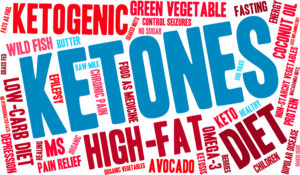Anybody who has researched popular ways to lose fat has probably read about cutting carbohydrates to get the body into a state of ketosis. While this kind of diet isn’t for everybody, many people have managed to lose weight, curb cravings, and even alleviate some health conditions this way. This article explains more about this fat-loss strategy and how to get into ketosis.
How To Get Into Ketosis
 Typically, human bodies rely first on carbohydrates in food for energy because these are the easiest sources to use. In the simplest terms, ketosis simply describes a natural state when the body relies upon fat and not carbohydrates as the main source of energy. For healthy people, this state can happen naturally when a person fasts or simply enjoys a low-carbohydrate diet. Deprived of carbohydrates, the body will use stored fat as the energy that it needs to fuel activity and brain function.
Typically, human bodies rely first on carbohydrates in food for energy because these are the easiest sources to use. In the simplest terms, ketosis simply describes a natural state when the body relies upon fat and not carbohydrates as the main source of energy. For healthy people, this state can happen naturally when a person fasts or simply enjoys a low-carbohydrate diet. Deprived of carbohydrates, the body will use stored fat as the energy that it needs to fuel activity and brain function.
The amount of carbohydrates that a dieter can eat in ketosis might vary because of activity level, body size, and metabolism. Typically, keto dieters restrict their daily carbohydrate intake to less than 20 grams a day for the first week or two of the diet. However, some diet plans allow as many as 50 grans of carbohydrates a day.
After the body starts to burn fat and go into ketosis, dieters might also add a few more grams of carbohydrates back in to vary their diets. Then they can adjust the diet to work for their individual body type and lifestyle. Still, it’s important to follow the diet very strictly in the first couple of weeks, so the body has time to adjust.
What Is A Ketogenic Diet?
A keto diet restricts carbohydrates, but it still lets dieters enjoy many kinds of health food. This list has the basics of the kinds of food to enjoy or avoid to achieve a state of ketosis:
* Some examples of food that contain no or few carbohydrates include natural fat, meat, seafood, cheese, and most vegetables that grow above the ground. Some fruit, like berries, also contain few carbohydrates.
* Tubers, grains, fruit, starches, legumes, and anything with added sugar will tend to contain a lot of carbohydrates, so they should be mostly avoided during the first phases of this diet. Many of these examples may be health food, but they won’t work for somebody who wants to get their body into ketosis.
Is Ketosis Safe?
In some cases, doctors even prescribe this kind of diet of patients with certain diseases. They actually discovered low-carbohydrate diets when treating epileptic patients many decades ago. On the other hand, people who suffer form certain diseases, like diabetes, should consult with their physician before trying a low-carbohydrate diet.
On the other hand, some diabetics have found that a low-carbohydrate diet has helped them manage their disease better, but it’s best to work with a doctor.
For most people, the diet should be safe, particularly if only used as a temporary measure. Some people feel tired or lethargic the first few days, but these symptoms usually go away as the body adjusts. Ketosis can provide a fat-loss solution for people who have not had good luck with more traditional types of diets.
